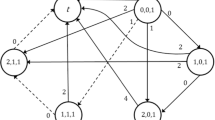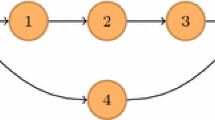Abstract
In scheduling problems with generalized due dates (gdd), the due dates are specified according to their position in the sequence, and the j-th due date is assigned to the job in the j-th position. We study a single-machine problem with generalized due dates, where the objective is maximizing the number of jobs completed exactly on time. We prove that the problem is NP-hard in the strong sense. To our knowledge, this is the only example of a scheduling problem where the job-specific version has a polynomial-time solution, and the gdd version is strongly NP-hard. A branch-and-bound (B&B) algorithm, an integer programming (IP)-based procedure, and an efficient heuristic are introduced and tested. Both the B&B algorithm and the IP-based solution procedure can solve most medium-sized problems in a reasonable computational effort. The heuristic serves as the initial step of the B&B algorithm and in itself obtains the optimum in most cases. We also study two special cases: max-on-time for a given job sequence and max-on-time with unit-execution-time jobs. For both cases, polynomial-time dynamic programming algorithms are introduced, and large-sized problems are easily solved.
Similar content being viewed by others
References
Du, J., & Leung, J. Y. T. (1990). Minimizing total tardiness on one processor is np-hard. Mathematics of Operations Research,15, 483–495.
Gerstl, E., & Mosheiov, G. (2017). Single machine scheduling problems with generalized due-dates and job-rejection. International Journal of Operations Research,55, 3164–3172.
Hall, N. G. (1986). Scheduling Mathematics of Operations Research problems with generalized due dates. IIE Transactions,18, 220–222.
Hall, N. G., Sethi, S. P., & Sriskandarajah, C. (1991). On the complexity of generalized due date scheduling problems. European Journal of Operational Research,51, 100–109.
Lann, A., & Mosheiov, G. (1996). Single machine scheduling to minimize the number of early/tardy jobs. Computers and Operations Research,23, 769–781.
Lawler, E. L. (1973). Optimal sequencing of a single machine subject to precedence constraints. Management Science,19, 544–546.
Mosheiov, G., & Oron, D. (2004). A note on the SPT heuristic for solving scheduling problems with generalized due dates. Computers and Operations Research,31, 645–655.
Qi, X., Yu, G., & Bard, J. F. (2002). Single machine scheduling with assignable due dates. Discrete Applied Mathematics,122, 211–233.
Sriskandarajah, C. (1990). A note on the generalized due dates scheduling problems. Naval Research Logistics,37, 587–597.
Tanaka, K., & Vlach, M. (1997). Single machine scheduling to minimize the maximum lateness with both specific and generalized due dates. IEICE Transactions on Fundamentals of Electronics, Communications and Computer Sciences,80, 557–563.
Tanaka, K., & Vlach, M. (1999). Minimizing maximum absolute lateness and range of lateness under generalized due dates on a single machine. Annals of Operations Research,86, 507–526.
Yin, Y., Cheng, S. R., Cheng, T. C. E., Wu, C. C., & Wu, W. H. (2012). Two-agent single-machine scheduling with assignable due dates. Applied Mathematics and Computation,219, 1674–1685.
Acknowledgements
This research was supported by the ISRAEL SCIENCE FOUNDATION (Grant No. 2505/19). The second author was also supported by the Charles I. Rosen Chair of Management and by The Recanati Fund of The School of Business Administration, The Hebrew University, Jerusalem, Israel.
Author information
Authors and Affiliations
Corresponding author
Additional information
Publisher's Note
Springer Nature remains neutral with regard to jurisdictional claims in published maps and institutional affiliations.
Appendix A: problems Sets for the numerical tests
Appendix A: problems Sets for the numerical tests
Problem Set 1:
Number of jobs: \( n = 10, 11, 12, 13, 14, 15. \)
Job processing times were generated uniformly in the interval \( \left[ {1,50} \right]. \)
Due dates were generated uniformly in the interval \( \left[ {1,Q} \right], \) where \( Q = \alpha \mathop \sum \limits_{j = 1}^{n} p_{j} . \)
Tightness factor: \( \alpha = 0.75, 1.0, 1.25. \)
Problem Set 2:
Number of jobs: \( n = 100. \)
Job processing times were generated uniformly in the interval \( \left[ {1,100} \right]. \)
Due dates were generated uniformly in the interval \( \left[ {1,Q} \right], \) where \( Q = \alpha \mathop \sum \limits_{j = 1}^{n} p_{j} . \)
Tightness factor: \( \alpha = 0.75, 1.0, 1.25. \)
Problem Set 3:
Number of jobs: \( n = 10, 20, \ldots , 70 \)
Job processing times were generated uniformly in the interval \( \left[ {1,50} \right]. \)
Due dates were generated uniformly in the interval \( \left[ {1,Q} \right], \) where \( Q = \alpha \mathop \sum \limits_{j = 1}^{n} p_{j} . \)
Tightness factor: \( \alpha = 0.75, 1.0, 1.25. \)
Problem Set 4:
Number of jobs: \( n = 100, 200, \ldots ,1000. \)
Job processing times were generated uniformly in the interval \( \left[ {1,50} \right]. \) Due dates were generated uniformly in the interval \( \left[ {1,Q} \right], \) where \( Q = \alpha \mathop \sum \limits_{j = 1}^{n} p_{j} . \)
Tightness factor: \( \alpha = 0.75, 1.0, 1.25. \)
Rights and permissions
About this article
Cite this article
Gerstl, E., Mosheiov, G. Single machine scheduling to maximize the number of on-time jobs with generalized due-dates. J Sched 23, 289–299 (2020). https://doi.org/10.1007/s10951-020-00638-7
Published:
Issue Date:
DOI: https://doi.org/10.1007/s10951-020-00638-7




